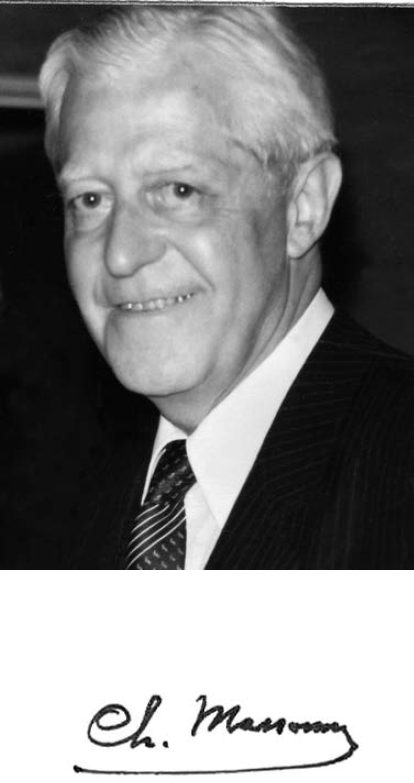CHARLES E. MASSONNET
1914–1996
Elected in 1978
“Contributions to advanced structural theory and understanding of the behavior of metal structures.”
BY STEVEN J. FENVES
CHARLES ERNEST MASSONNET, a prominent European educator and researcher on structural steel construction and initiator of many international collaborations in the field, died April 4, 1996, at the age of 82.
He was born March 14, 1914, in Arlon, in the south of Belgium, to Jules Massonnet, a pharmacist who served as mayor of Arlon and member of the Belgian Senate, and Louise (née Martha), a homemaker. He attended elementary and secondary school in Arlon and obtained his baccalaureate with an award of excellence.
He studied civil engineering at the University of Liège, graduating in 1936 with highest distinction. He drew the attention of his professors with his intellectual prowess, the clarity and precision of his reports and lab books, and his relevant comments in class.
In 1936–1937 he served in the Belgian Army’s 30th Artillery Regiment and then began his professional career in the Civil Engineering Department at the University of Liège. Shortly afterward, he won a research grant and a competitive state
___________________
This tribute was prepared with substantial assistance from Emeritus Professor René Maquoi of the University of Liège.
travel award, but his career was interrupted for six years by World War II.
Mobilized in August 1939 as a reserve sublieutenant, he was captured by the German army in May 1940 and held as a prisoner of war until liberated on May 17, 1945. During his captivity, despite the hardships and the near total lack of reference documents, he lectured to his fellow prisoners, prepared original papers, and even had some of these published. Throughout his captivity, he remained resolute, refusing submission and despair.
He returned to the university with preliminary research ideas that he had formed in captivity. At the age of 31 he assumed a position vacated by the death of the professor of strength of materials and went on to have an extraordinarily fruitful academic career.
For more than 30 years he led a staff at the university that eventually grew to about 30 persons. He attracted researchers from abroad and established close connections with research centers in Europe, the United States, and Japan. Research areas included many forms of buckling, shear lag, postbuckling strength, fracture mechanics, plastic design, structural connections, finite element methods and related software, boundary elements, and large-scale tests.
In the United States he was a lecturer or visiting professor at the universities of Illinois at Urbana-Champaign, Stanford, Lehigh, Cornell, Brown, California (Berkeley and Los Angeles), MIT, and Washington.
He lectured at research centers all over the world and participated in many international colloquia, conferences, and congresses. The Second International Colloquium on Stability was held in Liège in April 1977 under his leadership. Advances in the field of steel structures that were presented at this colloquium and its sister venues were reflected in the European Recommendations for Steel Construction, published in 1978, that formed the basis of the draft European standard “Eurocode 3: Design of Steel Structures” a few years later.
He produced more than 230 papers and five books: two on the strength of materials, and one each on plastic design
(coauthored with M.A. Save), on the design of orthotropic decks (the Guyon-Massonnet method), and on the use of computers for the design of civil engineering structures (the first book in French on the topic).
Beyond his academic activities, Professor Massonnet and his collaborators were consultants or advisors for design offices and public agencies. For 25 years he was a consultant to SECO, the Belgian nonprofit organization that has served as the country’s technical control bureau for construction. In that capacity he was Belgium’s premier forensic engineer on the strength, stability, and safety of steel structures. He personally investigated and provided testimony on major structural issues, including failures, and he assigned investigators to lesser cases.
When he first joined SECO, one of his duties was to check the design of many pavilions for the 1958 Brussels World Exhibition. Among these was the outstanding structure designated the Atomium, which has become the “banner” of Brussels as the capital of Belgium as well as Europe.
He was active in a number of other organizations as well, such as the International Association for Bridges and Structural Engineering (IABSE), the European Convention for Constructional Steelwork (ECCS), and the North American Structural Stability Research Council (SSRC). He chaired the scientific committee of the AILg (l’Association des Ingénieurs Diplômés de l’Université de Liège [Association of Civil Engineer Graduates of the University of Liège]) and was president of the association from 1979 to 1982.
Among Professor Massonnet’s professional awards were the AILg Gold Medal (1955) and the Louis Baes Award of the Belgian Royal Academy (1963). He was also honored by election as a foreign member of the Accademia di Scienze e Lettere, Instituto Lombardo, Milan (1974); foreign associate of the US National Academy of Engineering (1978); foreign member of the Polish Academy of Sciences (1980); and honorary member of the Polish Association of Theoretical and Applied Mechanics (1982). He received honorary doctorates from Chalmers University of Technology, Göteborg (1976) and the Swiss Federal Institute of Technology (ETH Zürich; 1977).
In 1984, on the occasion of his retirement and his 70th birthday, he received, in homage to his career, a festschrift from friends and colleagues, titled Verba Volant, Scripta Manent (“words fly away, writings remain”).
Charles Massonnet married Joanna Lisette Paula Marx in April 1946. Over the years they extended their hospitality to colleagues, friends, visitors, and collaborators (the present writer included), either in their apartment with a sweeping view of the river Meuse or in their country house in hilly Nandrin.
Lisette died in 2009 at the age of 84. Lisette and Charles are survived by sons André and Jean-Charles and daughter Suzon.
Charles Massonnet’s cheerful attitude, prodigious memory, and unbounded curiosity gained him friends and admirers wherever he went.







